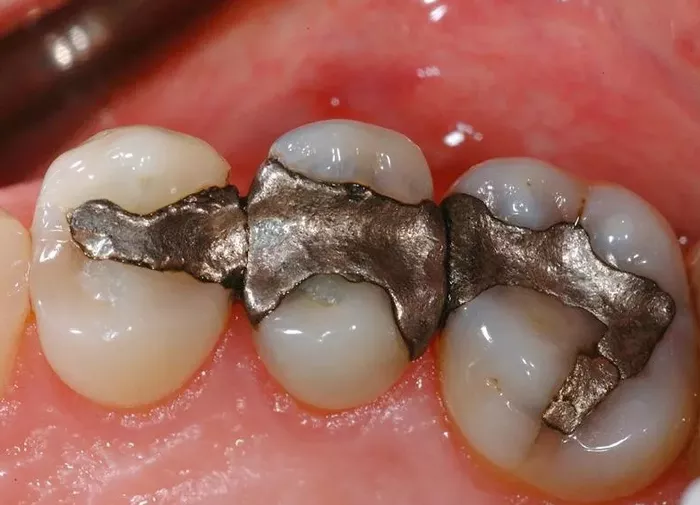Dental fillings are a common restorative solution used to treat cavities and tooth decay. Among various teeth filling types, amalgam fillings have been widely used for over a century due to their strength and durability. But what exactly are amalgam fillings, and how do they compare to modern alternatives?
What are Amalgam Fillings?
Amalgam fillings, often referred to as “silver fillings,” are a type of dental restoration made from a mixture of metals. This alloy typically includes mercury (approximately 50%), silver, tin, and copper. Despite the presence of mercury, dental amalgam has been deemed safe by numerous health authorities due to its stable chemical composition when combined with other metals.
History and Background
The use of dental amalgam dates back to the early 1800s. It gained rapid popularity due to its cost-effectiveness, ease of application, and exceptional longevity. While its use has declined in favor of tooth-colored composite materials, amalgam remains a viable option, especially for molar restorations where strength is essential.
Composition of Dental Amalgam
The unique strength of amalgam fillings comes from their metal composition:
Mercury (50%): Used to bind the metals into a pliable paste that hardens quickly.
Silver: Provides strength and corrosion resistance.
Tin: Increases workability and setting time.
Copper: Improves strength and reduces corrosion.
Small amounts of other metals may also be included to enhance specific properties.
Benefits of Amalgam Fillings
Despite newer materials available today, amalgam fillings offer several distinct advantages:
Durability: Amalgam fillings are known to last 10–15 years or more with proper care.
Strength: Ideal for back teeth that endure heavy chewing forces.
Cost-effective: Typically less expensive than composite or ceramic fillings.
Quick placement: Easier to apply and shape compared to other materials.
Potential Drawbacks of Amalgam Fillings
While amalgam is effective, it’s not without its downsides:
Appearance: The metallic color is highly visible and does not match tooth enamel.
Expansion and Contraction: Over time, amalgam can expand and contract with temperature changes, possibly leading to tooth fractures.
Mercury Concerns: Although studies show it’s safe, the presence of mercury raises concerns for some patients.
Removal complexity: Replacing amalgam can be more complex than composite fillings.
Teeth Filling Procedure with Amalgam
The teeth filling procedure using amalgam generally follows these steps:
Anesthesia: The dentist numbs the area around the affected tooth.
Decay Removal: The decayed part of the tooth is removed using a dental drill.
Tooth Preparation: The cavity is shaped to hold the filling securely.
Amalgam Application: The mixed amalgam is placed into the cavity and shaped to match the tooth’s contours.
Hardening: Amalgam hardens quickly, allowing normal function shortly after the procedure.
Longevity and Maintenance
Amalgam fillings are celebrated for their longevity. Many can last over 15 years, particularly with good oral hygiene practices. However, over time, they may wear down or cause slight staining around the tooth. Regular dental checkups can identify any issues early, allowing for timely intervention.
Cost Considerations
Amalgam fillings are among the most affordable teeth filling cost options available. The price varies based on geographic location, the size of the cavity, and the dental practice, but it remains significantly less expensive than composite or ceramic alternatives. Most dental insurance plans cover amalgam fillings for posterior teeth.
Amalgam vs. Composite Fillings
Choosing between amalgam and composite fillings often depends on various factors including location of the tooth, aesthetics, budget, and patient preference.
Appearance: Composite fillings blend with natural tooth color, while amalgam is silver.
Durability: Amalgam tends to last longer in high-pressure areas.
Time: Amalgam is quicker to place than composite fillings.
Cost: Amalgam is generally more affordable.
Safety of Mercury in Amalgam
The primary concern surrounding amalgam is its mercury content. It’s important to note that the mercury is chemically bound to other metals in the alloy, forming a stable compound. Reputable organizations including the American Dental Association (ADA), World Health Organization (WHO), and U.S. Food and Drug Administration (FDA) consider dental amalgam safe for adults and children over the age of six.
When to Choose Amalgam Fillings
Amalgam fillings are often recommended in the following cases:
Back teeth restorations: Where chewing pressure is highest.
Large cavities: That require a strong, supportive material.
Limited budget: When cost is a deciding factor.
Quick procedures: When minimal appointment time is preferred.
Contraindications for Amalgam
Although safe for most patients, amalgam may not be ideal for:
- People with documented mercury allergies.
- Pregnant or breastfeeding women (as a precaution).
- Patients with chronic kidney conditions.
- Individuals requesting aesthetically pleasing, tooth-colored restorations.
Alternatives to Amalgam Fillings
Today’s dental patients have access to a variety of teeth filling materials. Alternatives include:
Composite resin: Tooth-colored and widely used in visible areas.
Ceramic (porcelain): Durable and aesthetic, but more expensive.
Glass ionomer: Releases fluoride, ideal for temporary fillings or children’s teeth.
Gold: Durable and biocompatible, but costly and visible.
How to Maintain Teeth with Amalgam Fillings
Proper care ensures the longevity of amalgam fillings. Key maintenance tips include:
Brushing twice daily with fluoride toothpaste.
Flossing daily to prevent decay between teeth.
Routine dental checkups every 6 months.
Monitoring for cracks or sensitivity around filled teeth.
Avoiding hard foods that could fracture the filling or surrounding tooth.
How Amalgam Fillings Are Replaced
If an amalgam filling wears out, fractures, or leaks, a dentist may recommend replacement. The removal process involves:
- Protective barriers to minimize mercury exposure.
- Sectioning the filling to reduce heat and debris.
- Careful suction to collect all particles.
- Placement of a new filling—often composite or ceramic, depending on preference and need.
Conclusion
Amalgam fillings remain a valuable dental restoration option. They provide strength, durability, and cost-effectiveness, especially for posterior teeth. While modern alternatives like composite and ceramic fillings offer aesthetic advantages, amalgam’s long-standing track record makes it a reliable choice in many clinical scenarios. By understanding the benefits, limitations, and safety considerations, patients can make informed decisions with their dental professionals.
Related topics:

